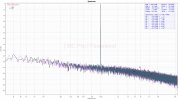I received my MC PRO this morning and was able to put it through its paces. Thanks to Michael for a prompt response and shipping right after a holiday weekend!
Out of the box, the MC PRO is handsome and well-built. The included transformer is substantial. Overall, it's a bit larger than I imagined, particularly compared to something like a Schiit Mani, though I have no complaints with the size.
This unit replaced a step-up transformer that I previously ran into the phono stage of my Integra DRX-8.4 AVR. Ground-noise has been an issue with this setup, though I've mostly mitigated the issue with some high quality ground wires (and fork connectors). However, cable routing remained an annoyance with this solution. With the MC PRO installed, I am now running balanced cables from the pre-amp to the AVR and unbalanced RCA + ground from the turntable to the pre-amp. I'm happy with an overall cleaner installation.
I conducted some unscientific tests to compare ground hum and noise floor using an SPL meter measured 6" from the mid/tweeter in my right tower. The turntable, pre-amp, and AVR were all powered on and the AVR was set to a relative level of -8 dB. I used the low-gain setting of 63 dB on the MC PRO. The Sumiko Songbird low-output MC cartridge was mounted. Here are the results:
| DRX-8.4 Phono + SUT (RCA-in) | MC PRO (XLR-in, Low Gain) |
| Ambient Background (OFF) | 36.5 dB | 36.5 dB |
| No Ground Wire Attached | 40.5 dB | N/A |
| Audible Noise Floor (ON) | 39.0 dB | 37.5 dB |
I ran each test 3 times and it would appear that the MC PRO is up to 1.5 dB quieter than the receiver's phono stage + SUT, and of course, has no audible ground hum. This is a pleasant surprise because I honestly expected no difference aside from easier cable routing! Now, could I tell the difference when listening to actual music? Absolutely not. But with no content playing, the difference is audible.
In terms of content, I gave it a try with some of my best mastered albums, including the UHQR release of
Kind of Blue on 200gr 45 RPM vinyl. I also auditioned Yuja Wang's recording of Prokofiev's
Sonata No. 8 (180gr 33 1/3) and Diana Krall's
Turn Up The Quiet (180gr 33 1/3). I refuse to engage in any audiophile fever dreams, so I'll just note that each album sounded excellent, as they always do.
Some photos -- an optimized installation will have to wait for the weekend:


